Archaeological Ceramic Fabric Attribution Through Material Characterisation—A Case-Study from Vale Pincel I (Sines, Portugal)
Abstract
1. Introduction
1.1. Neolithic Archaeometric Studies Conducted in Current Portuguese Territory
1.2. Archaeological Context of Vale Pincel I
- Group A presents a ceramic body with low compaction and high number of irregularly distributed non-plastic elements, usually quartz of large dimensions (>1 mm, reaching 5 mm). They present irregular and very friable surfaces of reddish colours, with a greyish to black fracture. All fragments present thick walls (sometimes > 20 mm). The fragments from this group are typically from globular pots with impressed decoration [28].
- Group B ceramics have compact ceramic bodies with numerous non-plastic elements of reduced dimensions (<0.5 mm), irregularly distributed, and a few bigger, between 0.5 and 1 mm. Its surfaces are well smoothed and of greyish-brown colours, with fractures of uniform colour, identic to the surface, or with greyish-black areas. The thickness of the walls rarely surpasses 7 mm. The ceramic from this group usually corresponds to spherical vessels and bowls of reduced dimensions [28].
2. Materials and Methods
2.1. Samples
2.2. Sample Preparation and Analytical Techniques
2.2.1. Microscopic Analysis
2.2.2. Elemental Analysis
2.2.3. Mineralogical Analysis
2.2.4. Sample Preparation
3. Results and Discussion
3.1. Textural Analysis
3.2. Chemical Elemental Analysis
- -
- Ti and Fe elements, probably associated with the nearby beach of S. Torpes, whose sands could be used as temper;
- -
- Al and P, which can be associated with the presence of bones and/or cooking ware, or with aluminum phosphates;
- -
- Na, Mg, and Ca that might be associated with local dolomite deposits and Na-feldspars;
- -
- Si and K, probably indicating the simultaneous use of quartz and K-rich feldspars.
3.3. Mineralogical Analysis
3.4. Attribution of Group C Ceramics
3.5. Ceramic Fabric Groups in Vale Pincel I
4. Conclusions
Supplementary Materials
Author Contributions
Funding
Data Availability Statement
Acknowledgments
Conflicts of Interest
References
- Whitbread, I.K. Fabric description of Archaeological Ceramics. In The Oxford Handbook of Archaeological Ceramic Analysis; Hunt, A., Ed.; Oxford University Press: Oxford, UK, 2016; pp. 200–216. [Google Scholar] [CrossRef]
- Moody, J.; Robinson, H.L.; Francis, J.; Nixon, L.; Wilson, L. Ceramic fabric analysis and survey archaeology: The Sphakia Survey. Annu. Br. Sch. Athens 2003, 98, 37–105. [Google Scholar] [CrossRef]
- Orton, C.; Hughes, M. Pottery in Archaeology, 2nd ed.; Cambridge Manuals in Archaeology; Cambridge University Press: Cambridge, UK, 2013. [Google Scholar]
- Lyons, M. Ceramic Fabric Classification of Petrogrphic Thin Section with Deep Learning. J. Comput. Appl. Archaeol. 2021, 4, 188–201. [Google Scholar] [CrossRef]
- Douglas Price, T.; Burton, J.H. An Introduction to Archaeological Chemistry, 1st ed.; Springer: New York, NY, USA; Dordrecht, The Netherlands; Heidelberg, Germany; London, UK, 2011. [Google Scholar]
- Stoltman, J.B. The Role of Petrography in the Study of Archaeological Ceramics. In Earth Sciences and Archaeology; Goldberg, P., Holliday, V.T., Ferring, C.R., Eds.; Springer: Boston, MA, USA, 2001; pp. 297–326. [Google Scholar] [CrossRef]
- Shepard, A.O. Ceramics for the Archaeologist; Carnegie Institution of Washington publication; Carnegie Institution of Washington: Washington, DC, USA, 1956. [Google Scholar]
- Ahmed, W.; Vander Voort, G. Petrographic Examination Methods. In Buehler TECHNotes; Buehler: Lake Bluff, IL, USA, 2015; Volume 3, pp. 1–5. [Google Scholar]
- Grim, R.E. Petrographic Study of Clay Materials. Clays Clay Technol. Natl. Conf. Clays Clay Technol. 1955, 1, 101–104. [Google Scholar] [CrossRef]
- Fowler, C.; Harding, J.; Hofmann, D. The Oxford Handbook of Neolithic Europe; Oxford Handbooks in Archaeology Series; Oxford University Press: Oxford, UK, 2015. [Google Scholar]
- da Veiga Ferreira, O.; Leitão, M. Portugal Pré-Histórico: Seu Enquadramento No Mediterrâneo; Biblioteca universitária; Publ. Europa-América: Lisboa, Portugal, 1985. [Google Scholar]
- Manzaneda, J.C.; García, X.C.; Rosselló, J.G.; Cólliga, A.M. Pottery forming of the Cardial and Epicardial Neolithic wares: Analysis and systematisation of technological traces from the ceramic productions of Cova del Frare (NE Iberian Peninsula, 5200-4800 BCE). J. Archaeol. Sci. Rep. 2022, 43, 103457. [Google Scholar] [CrossRef]
- de Lagrán, Í.G.-M. Recent Data and Approaches on the Neolithization of the Iberian Peninsula. Eur. J. Archaeol. 2015, 18, 429–453. [Google Scholar] [CrossRef]
- Perrin, T.; Manen, C. Potential interactions between Mesolithic hunter-gatherers and Neolithic farmers in the Western Mediterranean: The geochronological data revisited. PLoS ONE 2021, 16, e0246964. [Google Scholar] [CrossRef]
- Leppard, T.P. Process and Dynamics of Mediterranean Neolithization (7000–5500 bc). J. Archaeol. Res. 2022, 30, 231–283. [Google Scholar] [CrossRef]
- Zilhão, J. Radiocarbon evidence for maritime pioneer colonization at the origins of farming in west Mediterranean Europe. Proc. Natl. Acad. Sci. USA 2001, 98, 14180–14185. [Google Scholar] [CrossRef]
- Zilhão, J. Time is on my side. In Dynamics of Neolithisation in Europe; Oxbow Books: Oxford, UK, 2011; pp. 46–65. [Google Scholar] [CrossRef]
- Aubán, J.B. Indigenismo y migracionismo. Aspectos de la neolitización en la fachada oriental de la Península Ibérica. Trab. Prehist. 1996, 53, 37–54. [Google Scholar] [CrossRef]
- Bernabeu, J. The Social and Symbolic Context of Neolithization. 2002. Available online: https://api.semanticscholar.org/CorpusID:55420866 (accessed on 20 December 2024).
- Aubán, J.B.; Pérez, O.G.; Balaguer, L.M.; Borja, P.G. La cerámica neolítica durante el VI milenio cal AC en el Mediterráneo central peninsular. In Las Primeras Producciones Cerámicas: El VI Milenio cal AC en la Península Ibérica; Saguntum: Papeles del laboratorio de arqueología de Valencia, no. Extra-12; Universitat de València: Valencia, Spain, 2011; pp. 153–178. [Google Scholar]
- Soares, J.; Silva, C.T. A transição para o Neolítico na Costa Sudoeste portuguesa. In Muita Gente, Poucas Antas? Actas Do II Colóquio Internacional Sobre Megalitismo; Trabalhos de Arqueologia, 25; Património Cultural: Lisboa, Portugal, 2003; pp. 45–56. [Google Scholar]
- Masucci, M.; Carvalho, A.F. Ceramic Technology and Resource Use During the Early Neolithic in Central-Southern Portugal. Archaeometry 2016, 58, 201–221. [Google Scholar] [CrossRef]
- Jorge, A.; Dias, M.I.; Day, P.M. Plain pottery and social landscapes: Reinterpreting the significance of ceramic provenance in the Neolithic. Archaeometry 2013, 55, 825–851. [Google Scholar] [CrossRef]
- Ferreira, L.F.V.; Barros, L.; Machado, I.F.; Pereira, M.F.C.; Casimiro, T.M. An archaeometric study of a Late Neolithic cup and coeval and Chalcolithic ceramic sherds found in the São Paulo Cave, Almada, Portugal. J. Raman Spectrosc. 2020, 51, 483–492. [Google Scholar] [CrossRef]
- Inácio, N.; Gonçalves, V.S.; Sousa, A.C. Technology and Mobility: First Pottery Productions in Western Iberian Peninsula (Tagus estuary, Portugal). ArcheoSciences 2019, 43, 149–164. [Google Scholar] [CrossRef]
- Prudêncio, M.I.; Dias, M.I.; Trindade, M.J.; Braga, M.A.S. Rare earth elements as tracers for provenancing ancient ceramics. Estud. Quaternário Quat. Stud. 2012, 8, 6–12. [Google Scholar] [CrossRef]
- Barclay, K. Scientific Analysis of Archaeological Ceramics: A Handbook of Resources; Oxbow Books: Oxford, UK, 2001. [Google Scholar]
- Tavares da Silva, C.; Soares, J. Pré-História da Área de Sines: Trabalhos Arqueológicos de 1972-77; Gabinete da Área de Sines: Lisboa, Portugal, 1981. [Google Scholar]
- Tavares da Silva, C.; Soares, J. A estratégia do povoamento dos Chãos de Sines durante a Pré-História. In Volume D’hommage au Géologue Georges Zbyszewski, à L’occasion de son Passage à la Retraite, 22 Octobre 1979; Editions Recherche sur les Civilisations: Eugene, Oregon, 1984; pp. 393–410. [Google Scholar]
- Inverno, C.M.C.; Manuppella, G.; Zbyszewski, G.; Pais, J.; Ribeiro, M.L. Notícia Explicativa da Folha 42-C Santiago do Cacém; Departamento de Geologia—Instituto Geológico e Mineiro: Lisboa, Portugal, 1993. [Google Scholar]
- Carvalho, A.F. Produção cerâmica no início do Neolítico de Portugal. In Las Primeras Producciones Cerámicas: El VI Milenio cal AC en la Península Ibérica; Saguntum: Papeles del laboratorio de arqueología de Valencia, no. Extra-12.; Universitat de València: Valencia, Spain, 2011; pp. 237–250. [Google Scholar]
- Soares, J.; Mazzucco, N.; Clemente-Conte, I. The first farming communities in the Southwest European Coast: A traceological approach to the lithic assemblage of Vale Pincel I. J. Anthropol. Archaeol. 2016, 41, 246–262. [Google Scholar] [CrossRef][Green Version]
- Defranould, E.; Caro, J.; Bobœuf, M.; Manen, C.; Perrin, T. Mesolithic and Neolithic material productions in Aveyron (France) during the 6th millennium BC: Originality or adaptability? Neolit. West. Mediterr. New Debates Old Issue 2018, 472, 221–235. [Google Scholar] [CrossRef]
- Manen, C.; Guilaine, J. Aspects géographiques et chronoculturels du Néolithique ancien languedocien. In Premières Sociétés paysanes de Méditrranée occdentale. Structures des prodctions céramques; Société Préhistorique Française: Toulouse, France, 2010; pp. 179–189. [Google Scholar]
- Zilhão, J. From the Mesolithic to the Neolithic in the Iberian Peninsula. In Europe’s First Farmers; Douglas Price, T., Ed.; Cambridge University Press: Cambridge, UK, 2000; pp. 144–182. [Google Scholar]
- Chapman, R. Producing Inequalities: Regional Sequences in Later Prehistoric Southern Spain. J. World Prehistory 2008, 21, 195–260. [Google Scholar] [CrossRef]
- Malone, C. The Italian Neolithic: A Synthesis of Research. J. World Prehistory 2003, 17, 235–312. [Google Scholar] [CrossRef]
- Carvalho, A.F. Sobre a (in)existência de cerâmica de tipo Impressa no Neolitico Antigo do território Português. In Contextualizando la Cerámica Impressa: Horizontes Culturales en la Península Ibérica; Pardo-Gordó, S., Gómez-Bach, A., Montaña, M.M., Bernabeu Aubán, J., Eds.; Universitat Autònoma de Barcelona: Barcelona, Spain, 2020; pp. 173–182. [Google Scholar]
- Capelli, C.; Starnini, E.; Cabella, R.; Piazza, M. The circulation of Early Neolithic pottery in the Mediterranean: A synthesis of new archaeometric data from the Impressed Ware culture of Liguria (north-west Italy). J. Archaeol. Sci. Rep. 2017, 16, 532–541. [Google Scholar] [CrossRef]
- Binder, D. Mesolithic and Neolithic interaction in southern France and northern Italy: New data and current hypotheses. In Europe’s First Farmers; Price, T.D., Ed.; Cambridge University Press: Cambridge, UK, 2000; pp. 117–143. [Google Scholar] [CrossRef]
- Guilaine, J. The Neolithization of Mediterranean Europe—Mobility and Interactions from the Near East to the Iberian Peninsula. In The Oxford Handbook of Neolithic Europe; Fowler, C., Harding, J., Hofmann, D., Eds.; Oxford University Press: Oxford, UK, 2015; pp. 81–98. [Google Scholar]
- Borja, P.G.; Tortosa, J.E.A.; Aubán, J.B.; Pardo, J.J. Nuevas perspectivas sobre la Neolitización en la Cueva de Nerja (Málaga-España): La cerámica de la Sala del Vestíbulo. Zephyrus 2010, LXVI, 109–132. [Google Scholar]
- Silva, C.T.; Soares, J. Neolitização da costa sudoeste portuguesa. A cronologia de Vale Pincel I. In 5.o Congresso do Neolítico Peninsular; estudos & memórias, 8; Centro de Arqueologia da Universidade de Lisboa: Lisboa, Portugal, 2015; pp. 645–659. [Google Scholar]
- Guilaine, J.; Cremonesi, G. Torre Sabea. Un établissement du Néolithique ancien en Salento. Bull. Société Préhistorique Fr. 2003, 101, 908–910. [Google Scholar]
- Guilaine, J.; Manen, C.; Vigne, J.-D. Pont de Roque-Haute. Nouveaux Regards sur la Néolithisation de la France Méditerranéenne; Archives d’Écologie Préhistorique: Toulouse, France, 2007. [Google Scholar]
- Zaragoza, A.M.V.; Amilibia, A.M.M. Segunda Campaña de Excavaciones. La cueva de los Murciélagos, Zuheros (Córdoba) 1969; Excavaciones arqueológicas en España; Ministerio de Educación y Ciencia, Dirección General de Bellas Artes, Comisaria General de Excavaciones Arqueológicas: Córdoba, Spain, 1973. [Google Scholar]
- Camps, G. Les civilisations préhistoriques de l’Afrique du Nord et du Sahara. Rev. Mondes Musulmans Méditerranée 1975, 20, 179–181. [Google Scholar]
- Figueiredo, E.; Silva, R.J.; Araújo, M.F.; Fernandes, F.M.B. Multifocus Optical Microscopy Applied to the Study of Archaeological Metals. Microsc. Microanal. 2013, 19, 1248–1254. [Google Scholar] [CrossRef] [PubMed]
- Eigenvector Research Incorporated. Available online: https://eigenvector.com/software/solo/ (accessed on 15 January 2023).
- Holmqvist, E. Why not let them rest in pieces? Grog-temper, its provenance and social meanings of recycled ceramics in the Baltic Sea region (2900–2300 BCE). Archaeometry 2022, 64, 8–25. [Google Scholar] [CrossRef]
- Tite, M.S.; Kilikoglou, V.; Vekinis, G. Strength, Toughness and Thermal shock resistance of ancient ceramic, and their influence on technological choice. Archaeometry 2001, 43, 301–324. [Google Scholar] [CrossRef]
- Eramo, G. Ceramic technology: How to recognize clay processing. Archaeol. Anthropol. Sci. 2020, 12, 164. [Google Scholar] [CrossRef]
- Convertini, F. Bilan des études réalisées sur la provenance de la céramique du Néolithique ancien en Méditerranée nord-occidentale: Mise au point d’un protocole analytique. In Premières Sociétés Paysannes de Méditerranée Occidentale: Structure des Productions Céramiques; Manen, C., Convertini, F., Binder, D., Sénépart, I., Eds.; Société Préhistorique Française: Paris, France, 2010; pp. 13–28. [Google Scholar]
- Binder, D.; Clop, X.; Convertini, F.; Manen, C.; Sénépart, I. Les productions céramiques du Néolithique ancien entre Provence et Catalogne. In Les Productions Céramiques du Néolithique Ancien Entre Provence et Catalogne; Société Préhistorique Française: Paris, France, 2010; pp. 115–129. [Google Scholar]
- Clop, X. Caracterización petroarqueológica de cerámicas decoradas del Neolítico antiguo de la Península Ibérica. In Las Primeras Producciones Cerámica: El IV Milenio cal ac en la Península Ibérica; Bernabeu, J., Rojo, M.A., Molina, L., Eds.; Universitat de València: València, Spain, 2011; pp. 35–52. [Google Scholar]
- Duma, G. Phosphate Content of Ancient Pots as Indication of Use. Curr. Anthropol. 1972, 13, 127–130. [Google Scholar] [CrossRef]
- Maritan, L.; Mazzoli, C. Phosphates in Archaeological finds: Implications for environmental conditions of burial. Archaeometry 2004, 46, 673–683. [Google Scholar] [CrossRef]
- Rodrigues, S.F.S.; da Costa, M.L. Phosphorus in archeological ceramics as evidence of the use of pots for cooking food. Appl. Clay Sci. 2016, 123, 224–231. [Google Scholar] [CrossRef]
- da Costa, M.L.; Kern, D.C.; Pinto, A.H.E.; Souza, J.R.d.T. The ceramic artifacts in archaeological black earth (terra preta) from Lower Amazon Region, Brazil: Chemistry and geochemical evolution. Acta Amzonica 2004, 34, 375–386. [Google Scholar] [CrossRef]
- Hunt, A. (Ed.) The Oxford Handbook of Archaeological Ceramic Analysis; Oxford University Press: Oxford, UK, 2016. [Google Scholar] [CrossRef]
- Baxter, M.J. Standardization and Transformation in Principal Component Analysis, with Applications to Archaeometry. J. R. Stat. Soc. Ser. C Appl. Stat. 1995, 44, 513–527. [Google Scholar] [CrossRef]
- Ruiz-Perez, D.; Guan, H.; Madhivanan, P.; Mathee, K.; Narasimhan, G. So you think you can PLS-DA? BMC Bioinform. 2020, 21, 2. [Google Scholar] [CrossRef]
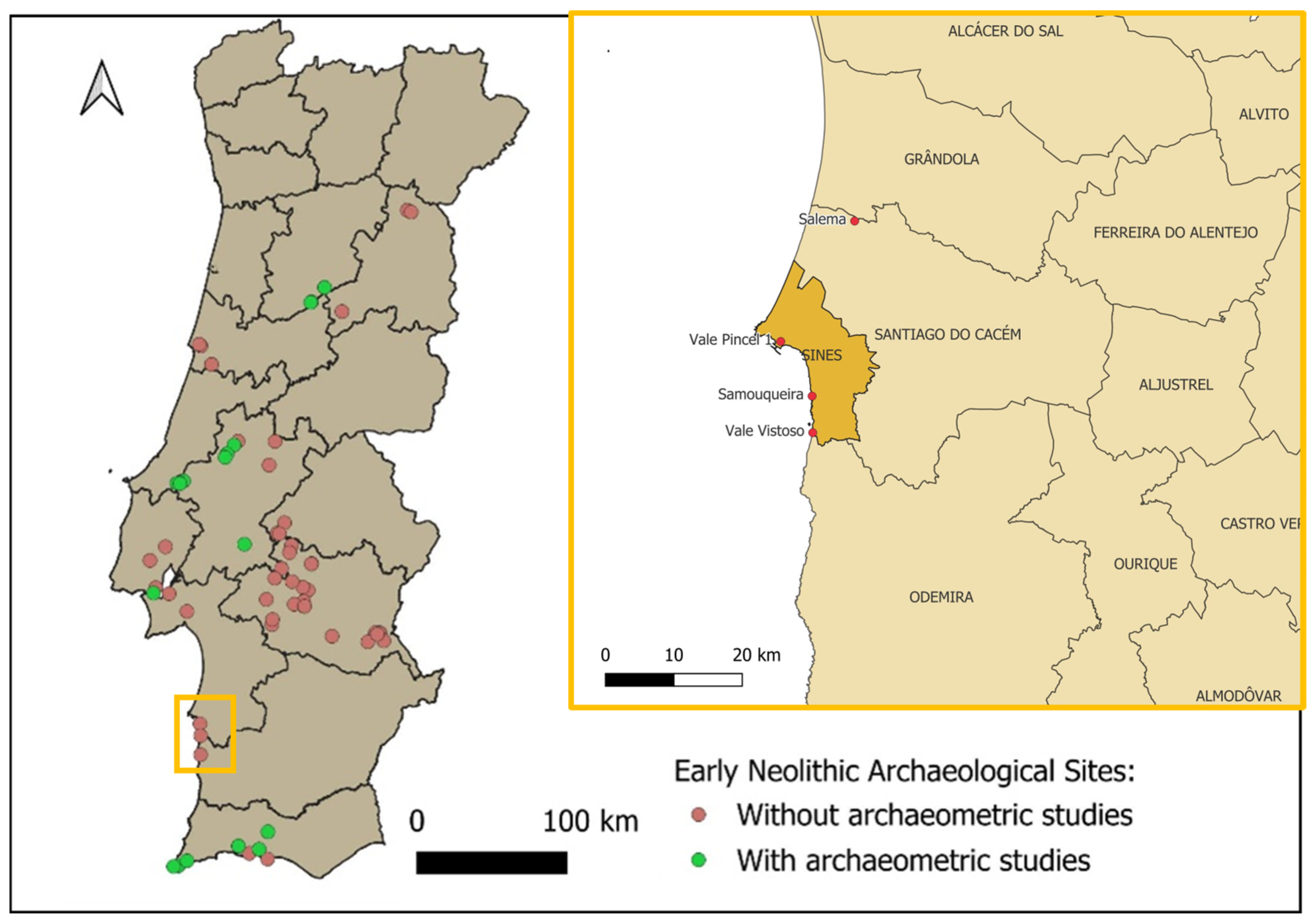



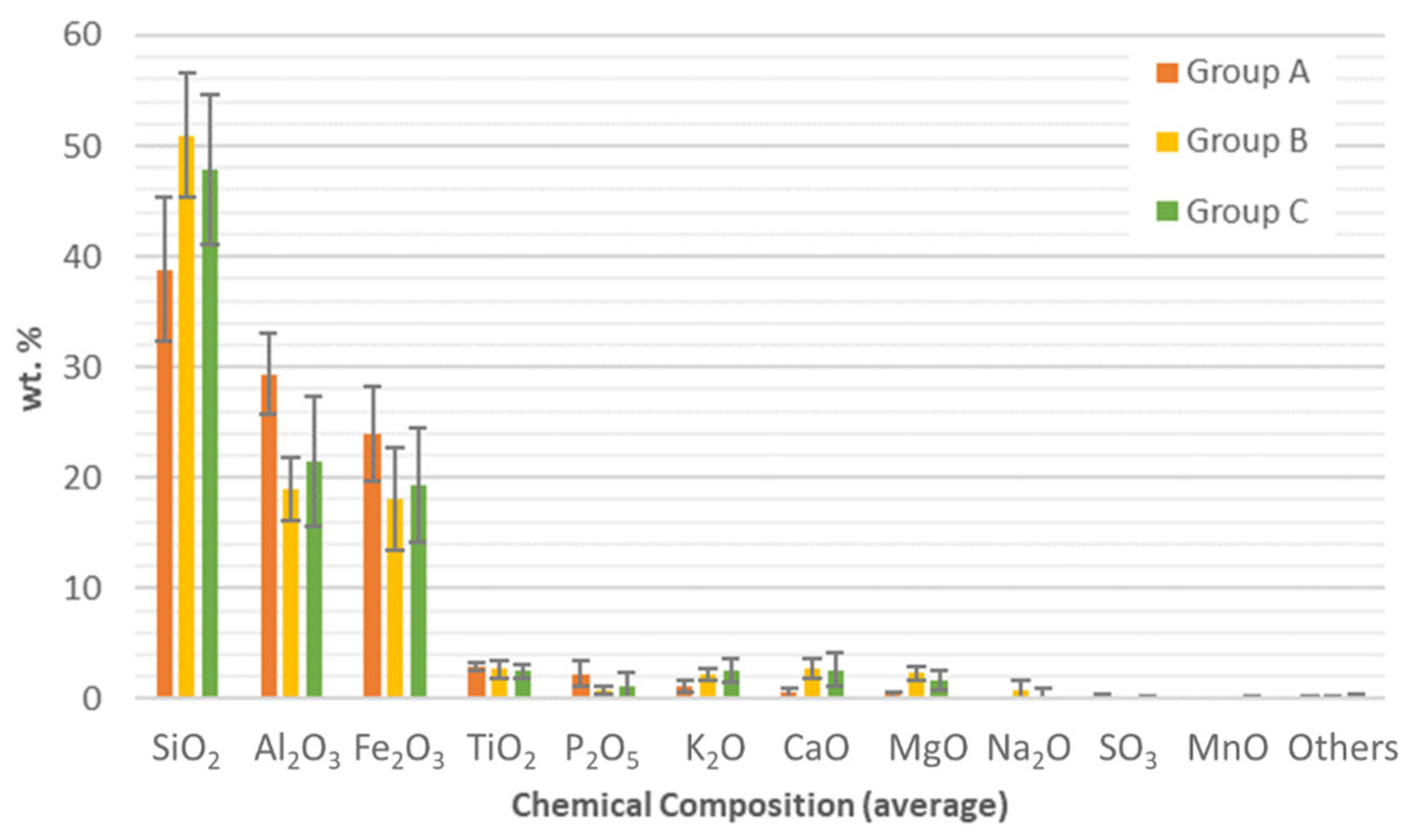
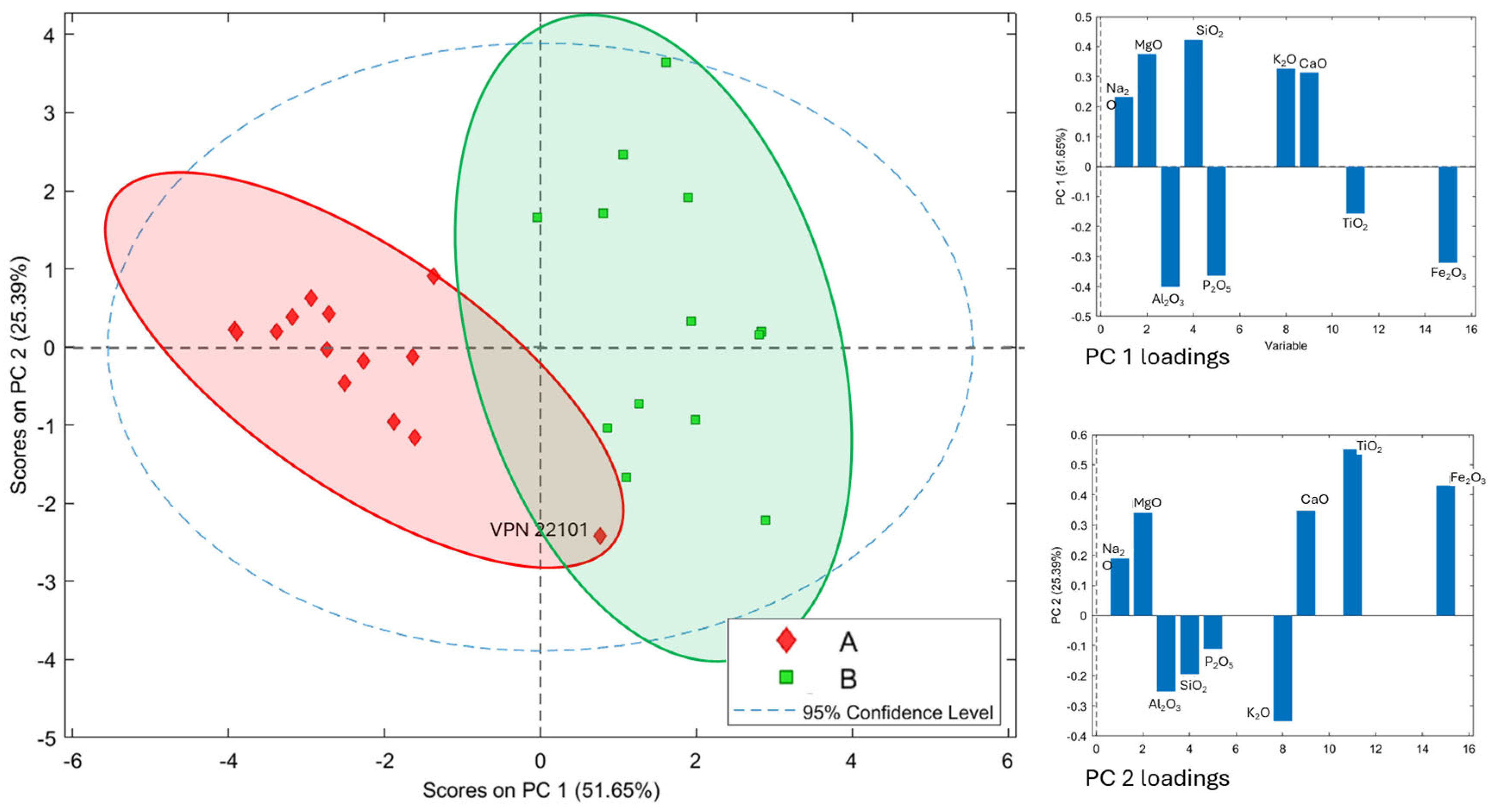

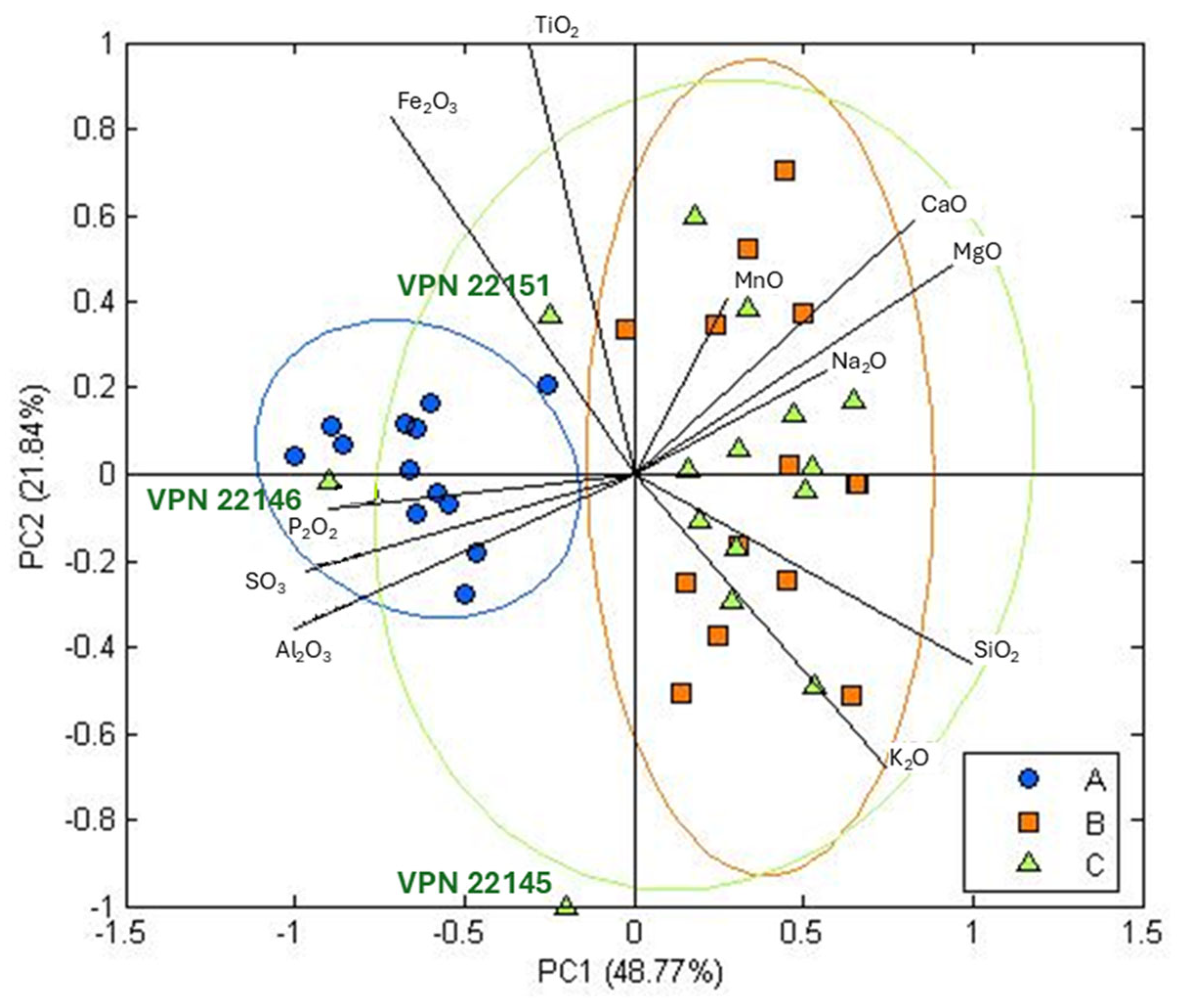
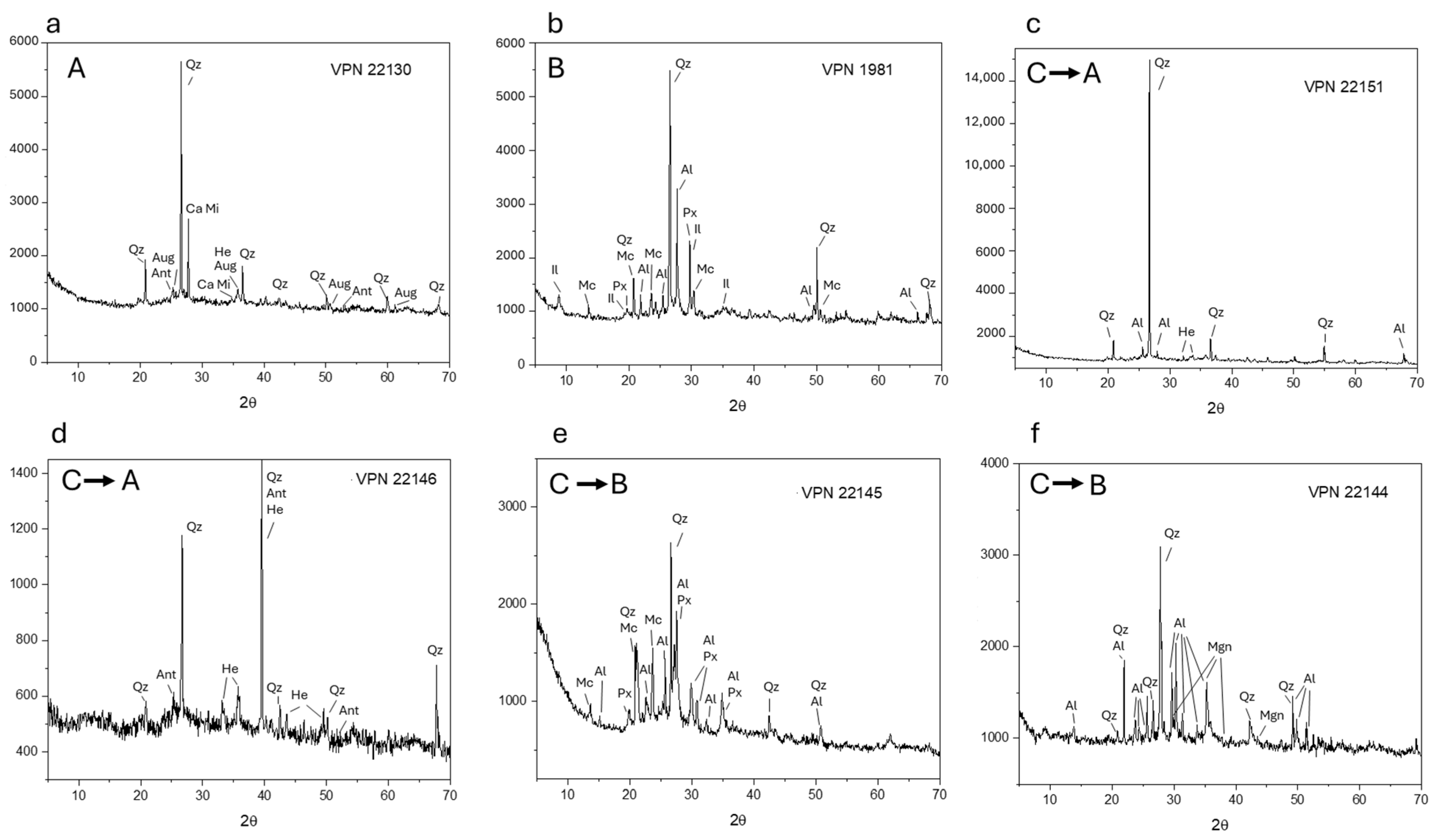
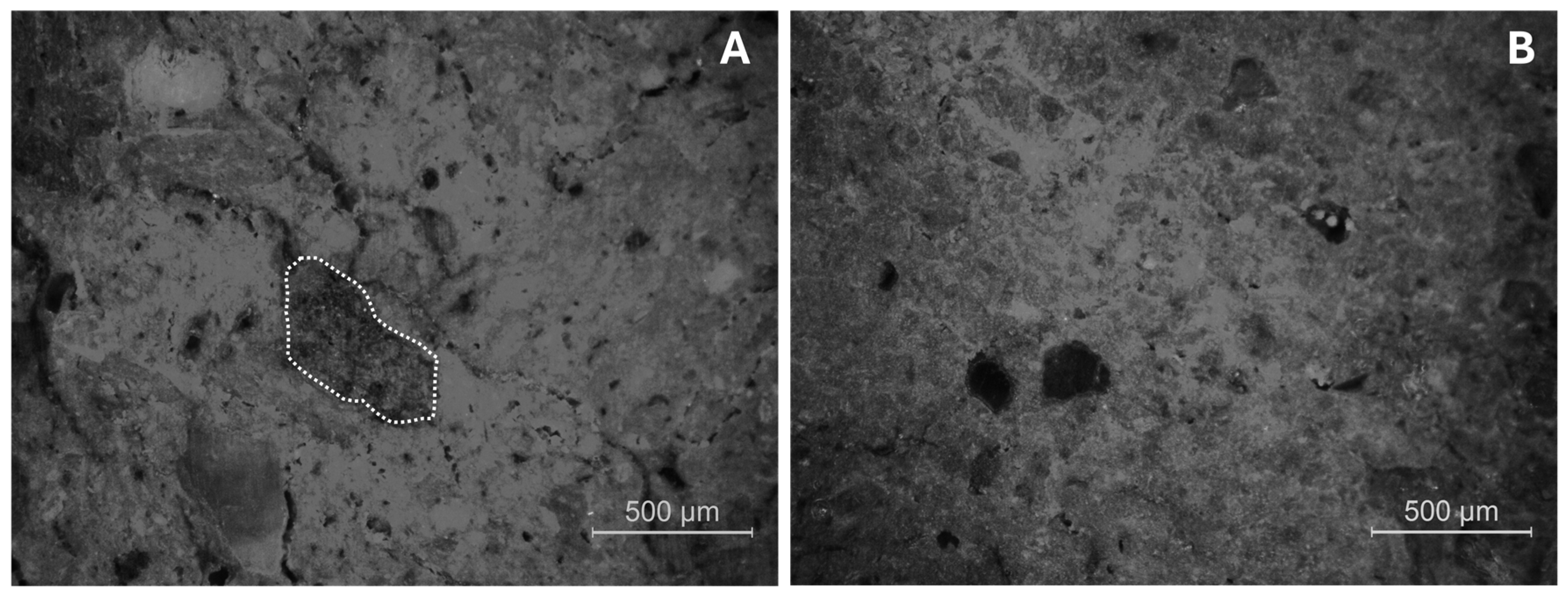
| Sample | Sector | Square | Stratigraphy | Colour | Friability | ||
|---|---|---|---|---|---|---|---|
| Surface | Core | ||||||
| Group A | VPN 8532 | XXVI | T16 | 2d | Light brown | Bright red | Friable |
| VPN 22101 | XXVI | S17 | 2b | Brown | Reddish | Friable | |
| VPN 22107 | - | - | Surface | Brown | Bright red | Very friable | |
| VPN 22116 | XXVII | O14 | 2b | Light brown | Bright red | Very friable | |
| VPN 22122 | XXVI | S8 | 2a | Light brown | Dark red | Compact | |
| VPN 22123 | XXVI | G7 | 2c | Brown | Reddish | Friable | |
| VPN 22124 | XXVII | E15 | 2c | Light brown | Bright red | Very friable | |
| VPN 22125 | XVII | I14 | 2c | Brown | Reddish | Friable | |
| VPN 22126 | XVII | P11 | 2c | Light brown | Brown | Friable | |
| VPN 22127 | XVII | I8 | 2d | Light brown | Bright red | Friable | |
| VPN 22128 | XVII | O6 | 2c | Brown | Bright red | Very friable | |
| VPN 22129 | XXVI | E15 | 2c | Dark brown | Dark red | Very friable | |
| VPN 22130 | XVII | P10 | 2d | Light brown | Light red | Compact | |
| VPN 22131 | XVII | R11 | 2c | Dark brown | Dark red | Compact | |
| Group B | VPN 1981 | XVII | F4 | 2c | Brown | Dark brown | Compact |
| VPN 22098 | XXVI | H14 | 2b | Grey | Dark grey | Compact | |
| VPN 22119 | XXVI | I13 | 2a | Brown | Brown | Compact | |
| VPN 22132 | XXVI | E15 | 2c | Light brown | Reddish | Friable | |
| VPN 22133 | XVIII | E7 | 2b | Light brown | Brown | Compact | |
| VPN 22134 | XVII | O8 | 2d | Brown | Dark brown | Compact | |
| VPN 22135 | XXVI | E13 | 2c | Light brown | Brown | Compact | |
| VPN 22136 | XVII | R12 | 2b | Grey | Dark grey | Friable | |
| VPN 22137 | XVII | E12 | 2c | Light brown | Dark grey | Compact | |
| VPN 22138 | XVI | G10 | 2c | Brown | Black | Compact | |
| VPN 22139 | VIII | F16 | 2a | Light brown | Reddish | Friable | |
| VPN 22140 | XVI | O17 | 2c | Light brown | Dark grey | Friable | |
| VPN 22141 | XVII | F15 | 2d | Brown | Dark grey | Compact | |
| Group C | VPN 22148 | XVII | D9 | 2b | Light brown | Bright red | Very friable |
| VPN 22109 | XXVI | I18 | 2a | Light brown | Light brown | Friable | |
| VPN 22117 | XVII | S16 | 2a | Light brown | Reddish | Very friable | |
| VPN 22142 | XVI | P4 | 2a | Light brown | Brown | Very compact | |
| VPN 22143 | VIII | I16 | 2a | Light grey | Grey | Compact | |
| VPN 22144 | XVII | E13 | 2b | Light brown | Reddish | Friable | |
| VPN 22145 | XXVII | T6 | 2b | Brown | Dark grey | Friable | |
| VPN 22146 | XXVII | I13 | 2c | Light brown | Light red | Friable | |
| VPN 22147 | XVI | G13 | 2b | Light brown | Brown | Compact | |
| VPN 22149 | XXVII | G14 | 2c | Light grey | Brown | Friable | |
| VPN 22150 | XXVII | E14 | 2c | Grey | Dark brown | Compact | |
| VPN 22151 | XVI | T3 | 2c | Light brown | Reddish | Very friable | |
| VPN 22152 | XVII | G2 | 2d | Light grey | Brown | Compact | |
| VPN 22153 | XVI | T3 | 2c | Light grey | Dark grey | Compact | |
| VPN 22154 | XVII | D9 | 2b | Light brown | Reddish | Very compact | |
| Group | Area of NPE (%) | NPE Size Range |
|---|---|---|
| A | 18.3 ± 2.4 | (0.5 ± 0.1) mm–(1.5 ± 0.3) mm |
| B | 15.9 ± 2.5 | (0.3 ± 0.1) mm–(0.7 ± 0.2) mm |
| C | 14.6 ± 4.1 | (0.3 ± 0.1) mm–(1 ± 0.2) mm |
| Group C Samples | Attribution After Analysis |
|---|---|
| VPN 22148 | Group B |
| VPN 22109 | Group B |
| VPN 22117 | Group B |
| VPN 22142 | Group B |
| VPN 22143 | Group B |
| VPN 22144 | Group B |
| VPN 22145 | Group B |
| VPN 22146 | Group A |
| VPN 22147 | Group B |
| VPN 22149 | Group B |
| VPN 22150 | Group B |
| VPN 22151 | Group A |
| VPN 22152 | Group B |
| VPN 22153 | Group B |
| VPN 22154 | Group B |
| Vale Pincel Norte I Ceramic Fabrics | Group A | Group B |
|---|---|---|
| Macroscopic analysis | ||
| Ceramic matrix colour: | Reddish surfaces and brownish core—sandwich structure | Black to brown |
| Object typology: | Tall spherical vases with impress decoration | Spherical vases and bowls of reduced dimensions |
| Friability: | Very friable | Compact |
| Microscopic analysis | ||
| NPE frequency (%): | 17.5 ± 3.2 | 15.5 ± 3.4 |
| NPE distribution: | Random | Random |
| NPE size (mm): | 0.5–1.5 | 0.3–0.6 |
| NPE shape: | Sub-rounded and sub-angular | Majorly sub-angular |
| Chemical analysis | ||
| Higher Al2O3 and Fe2O3 wt.% | Higher SiO2 wt.% | |
| Mineralogical analysis | ||
| Quartz, Iron and/or Titanium oxides and Aluminum phosphates | Quartz, diverse Feldspars and Pyroxenes | |
Disclaimer/Publisher’s Note: The statements, opinions and data contained in all publications are solely those of the individual author(s) and contributor(s) and not of MDPI and/or the editor(s). MDPI and/or the editor(s) disclaim responsibility for any injury to people or property resulting from any ideas, methods, instructions or products referred to in the content. |
© 2025 by the authors. Licensee MDPI, Basel, Switzerland. This article is an open access article distributed under the terms and conditions of the Creative Commons Attribution (CC BY) license (https://creativecommons.org/licenses/by/4.0/).
Share and Cite
Saraiva, A.S.; Coutinho, M.L.; Tavares da Silva, C.; Soares, J.; Duarte, S.; Veiga, J.P. Archaeological Ceramic Fabric Attribution Through Material Characterisation—A Case-Study from Vale Pincel I (Sines, Portugal). Heritage 2025, 8, 84. https://doi.org/10.3390/heritage8030084
Saraiva AS, Coutinho ML, Tavares da Silva C, Soares J, Duarte S, Veiga JP. Archaeological Ceramic Fabric Attribution Through Material Characterisation—A Case-Study from Vale Pincel I (Sines, Portugal). Heritage. 2025; 8(3):84. https://doi.org/10.3390/heritage8030084
Chicago/Turabian StyleSaraiva, Ana S., Mathilda L. Coutinho, Carlos Tavares da Silva, Joaquina Soares, Susana Duarte, and João Pedro Veiga. 2025. "Archaeological Ceramic Fabric Attribution Through Material Characterisation—A Case-Study from Vale Pincel I (Sines, Portugal)" Heritage 8, no. 3: 84. https://doi.org/10.3390/heritage8030084
APA StyleSaraiva, A. S., Coutinho, M. L., Tavares da Silva, C., Soares, J., Duarte, S., & Veiga, J. P. (2025). Archaeological Ceramic Fabric Attribution Through Material Characterisation—A Case-Study from Vale Pincel I (Sines, Portugal). Heritage, 8(3), 84. https://doi.org/10.3390/heritage8030084








